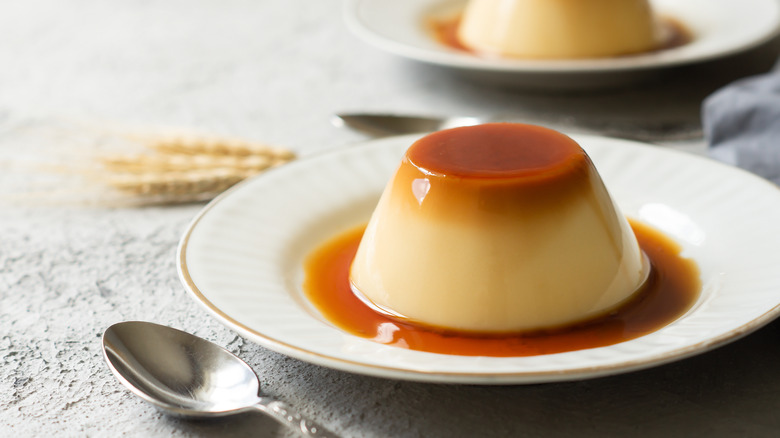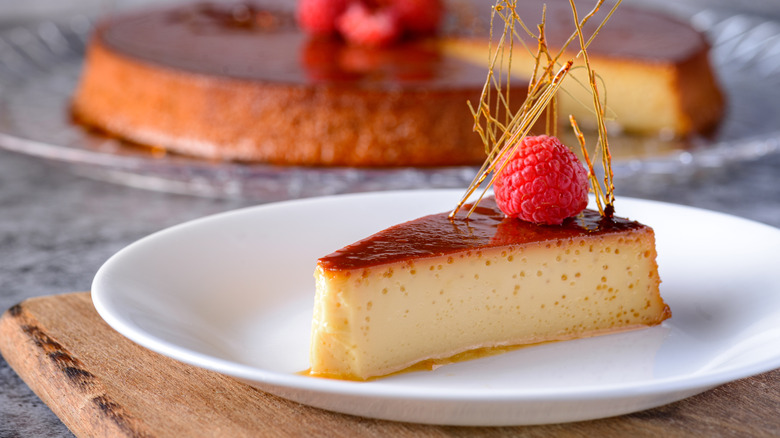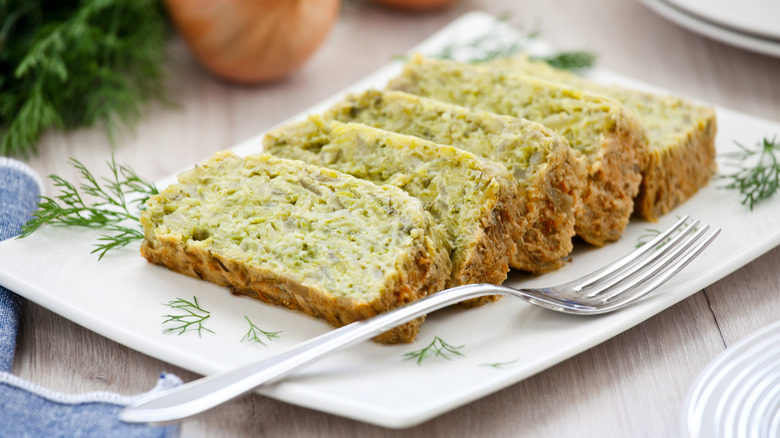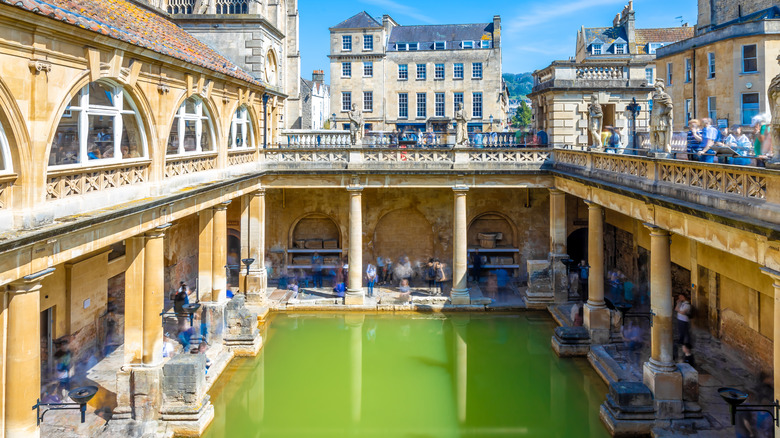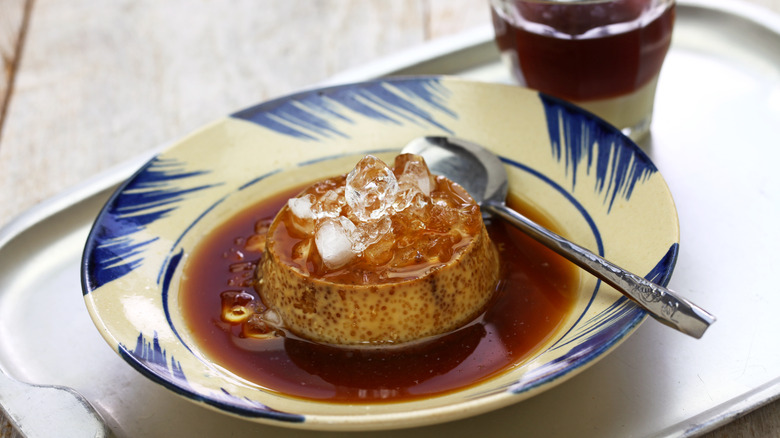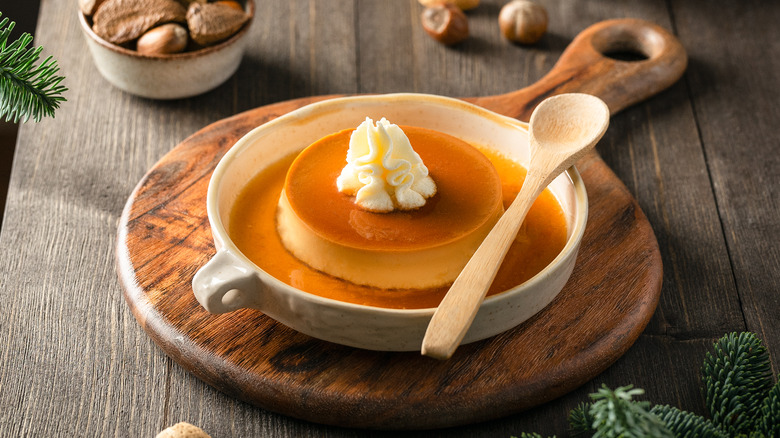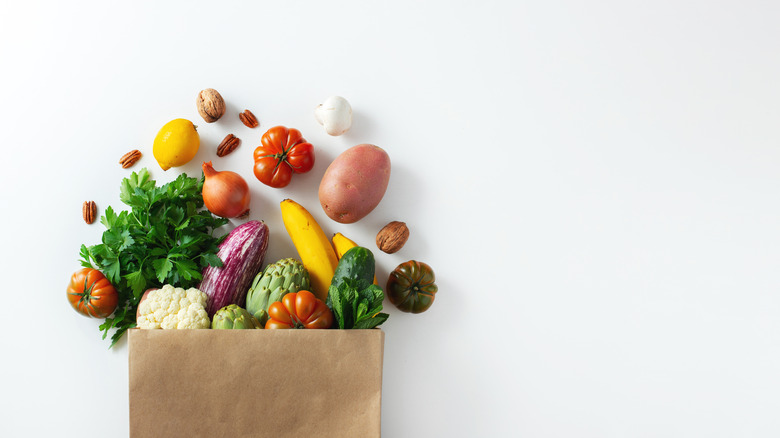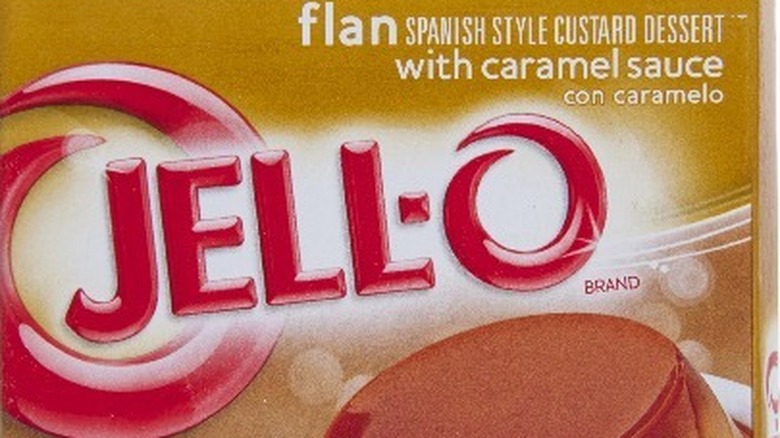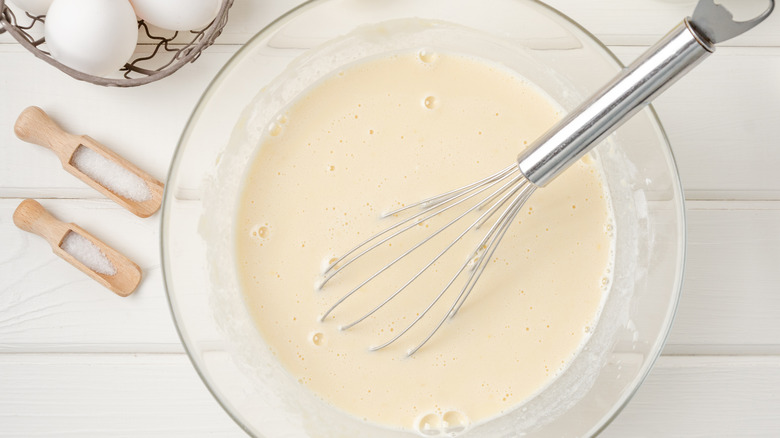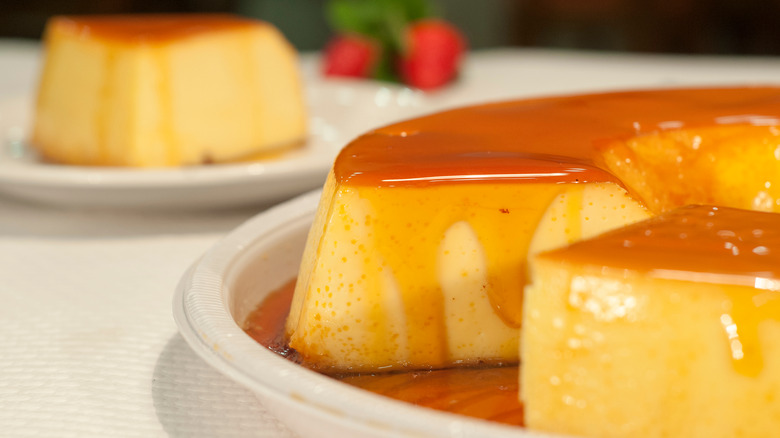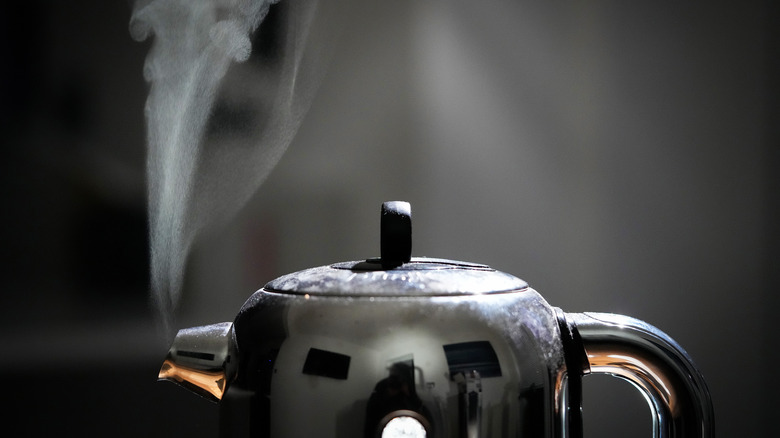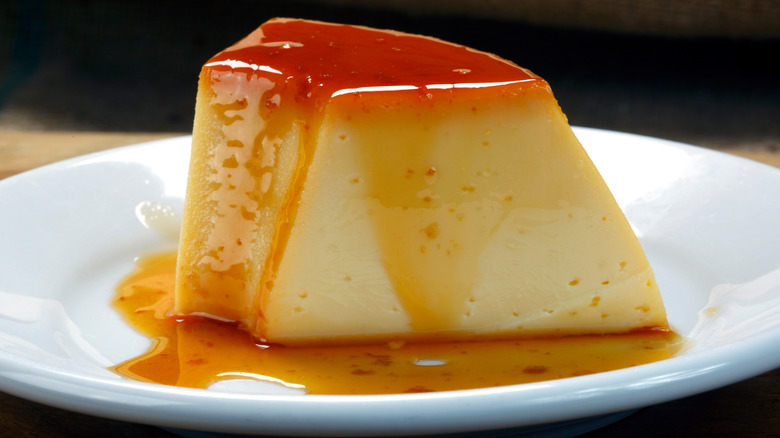The Untold Truth Of Flan
Flan is one of the great desserts. flan's few ingredients and simple methods have helped to make this self-saucing dessert a staple. Across the globe, this creamy, jiggly dessert has made a name for itself (of dubious pronunciation), showing up in pop culture, as well as our dining tables.
Dating back to the ancient Romans, flan has delighted tastebuds for centuries. With a history as long as this one, it's no wonder there is more to this dessert than its sweet taste. Flan has been found throughout the world's history: from 17th century Philippines to modern-day Spain and Latin America. Flan is one of those amazing foods that shows up across cultural lines. It may sometimes go by a different name, but it is all flan.
With all these amazing facilities to flan, you're probably wondering what else this dessert has in store? From what gives the dish its distinctive jiggle to the hot debate on how to pronounce it, we have you covered. So, pull up a chair, grab a slice, and let's dive into the untold truth of flan.
What is flan?
The most popular flan is the Spanish style or caramel flan. This simple yet scrumptious dessert is characterized by its thick and creamy custard base, more similar in texture to that of Jell-O than that of a traditional custard, and its layer of sweet and bitter caramel sauce on top. The custard holds its form perfectly when unmolded and served, while the caramel decadently oozes down the side. But that's not the only flan.
Flan can be used to describe a multitude of custard-based dishes, even those that involve a pastry base. Dictionary.com's first definition is of the most popular style, "Spanish cooking, a dessert of sweetened egg custard with a caramel topping." But it goes on to include the second, less commonly known kind of flan, "an open, tart-like pastry ... filled with custard and cream." While the crusts and toppings may differ, the creamy custard base is present in all varieties.
There are many flavor variations, including savory ones
Adding a pastry base isn't the only variation in flan; the flavor possibilities are endless. A look at any restaurant menus or recipes online for flan will reveal that caramel is generally the default topping flavor. But there are plenty of other choices out there. Variations include common dessert flavors such as citrus, vanilla, cinnamon, and coconut and rum. Coffee either added to the flan or poured on top is also popular.
But that is just the tip of the flavor iceberg. Flan can also be a savory dish and has been since its creation. It may seem strange to us, but the ancient Romans made savory flans, known as "eel flans." These were seen as part of the main meal, not a dessert. Savory flans included ingredients such as fish, vegetables, spices, and cheeses and were incorporated as part of the main diet. Eel flan was particularly common on dining tables in Europe during Lent, as they could be made without meat in observance of the religious custom. While savory flan is not as common today, its savory custard relative quiche still graces brunch tables.
Just how old is flan?
Flan has been around for an incredibly long time. One of the first written references to the word flan ( then spelled "flaunes") comes from Havelok The Dane, a 1300s B.C. English romance. It is thought that this reference to "flaunes" either referred to custards such as the popular Spanish style flan, or a cheese pie more similar to pastry-based flan. That's pretty old but is just the beginning. The dish itself is much older than that.
Flans were a staple in the diet of ancient Romans. According to "Food and Drink in Britain: From the Stone Age to the 19th Century" by C. Anne Wilson, when the Romans invaded England, it gave them greater access to and a means to incorporate a large number of eggs into the diet, which led to custards rise in popularity. But even this wasn't the actual beginning. Wilson continues, explaining that the Romans took from the Greeks the idea of adding milk to eggs in order to "form a custard mixture."
Flan is a worldly dessert
Flan is one of those remarkable dishes that exist simultaneously in cuisines worldwide. In Spain, flan can be found all over the country. The dish itself has become a staple in Spanish and Latin American cuisine. In addition, flan has been found all over Europe for centuries, sometimes showing up under a different name, such as crème caramel in France or rozata in Croatia.
The dish has also taken on popularity in Asia. In Japan, flan is a popular snack and can be found in Japanese convenience stores under the name "purin." In Vietnam, where the French introduced caramel and custard, flan is often made with a cup of Vietnamese coffee poured on top. This delicious variation possibly improves upon perfection by pairing the sweet dessert and the bitter coffee into beautiful harmony called Bánh Flan Cà Phe. Additionally, there is leche flan in the Philippines, which is markedly similar to Spanish-style flan, but even denser and richer. While the name may change, it is all flan.
Flan is a popular Christmas Eve treat
Most holidays have food that goes along with them. And what would a holiday table be complete without a signature dessert? For Christmas in England, there is Christmas pudding, Americans serve pie on Thanksgiving. However, in some parts of the world, a delicious holiday flan is the star of the show.
Flan can be enjoyed year-round. Flan's simple ingredients make it easy to source and produce no matter the season, especially if using canned dairy products like evaporated and condensed milk. That being said, there is one time of year flan is sure to find its way to the table. In Spain and Latin America, a jiggly jolly holiday flan is a staple on Noche Buena, or Christmas Eve. This decadent dessert adorns their Christmas Eve tables. Families in Latin America aren't the only ones who enjoy a Christmas flan. Over 19,000 kilometers away flan is also a popular holiday dessert in the Philippines.
How do you say it?
There is hot debate about how to pronounce the word "flan" correctly. And why wouldn't there be? The etymology of the word is all muddled up. According to The Etymology Dictionary, the term "flan" comes from the Old French word flaon, which meant "Flat-cake, tart, flan." This itself is derived from the medieval Latin word flado, which in turn is possibly derived from a Frankish or Germanic root such as the old high german flado and the middle high german vlade. Woof, that's a lot.
So, what is the correct way to say it? Well, the answer is "it depends." According to Forvo.com flan should be pronounced to rhymes with "plan." However, Spoon University states that the right way, according to the Spanish pronunciation, is to say "f-lawn," which rhymes with "lawn." Google's pronunciation engine offers both pronunciations as correct, offering the first as the British English, and the second as the American English pronunciation. Dictionary.com also offers both pronunciations as correct.
In the end, with roots in so many languages and cultures, it is impossible to say that only one pronunciation is correct. The good news is that no matter how you say it, the people you are talking to will likely know what you mean, even if they disagree with how you pronounce it.
The dessert was featured in The Office, twice
Not many shows have such a foothold in pop culture quite like "The Office," and in its premiere episode in the United States, flan made a special appearance. Coworkers and arch-nemeses Jim and Dwight are introduced to the audience as Dwight reaches into his desk drawer only to find that Jim has encased his stapler in Jell-O. Steve Carell's character Michael Scott reluctantly reprimands Jim. Jim then apologizes to Dwight, stating, "Dwight, I'm sorry because I've always been your biggest flan." This encounter sets up the dynamic that would last through the series.
But that's not all. Flan jokes are one of the few things that made it into both the U.S. and the U.K. iterations of the show. In Season 2, Episode 3 of the British version, an impromptu office birthday party is held where David Brent, played by Ricky Gervais, is clearly unhappy about being there. After exhausting his repertoire of complaints, he takes a bite of the cake and announces, "I prefer flan." The joke became so popular that you can now even buy t-shirts with the phrase.
Despite the U.S. and the U.K. itineration sharing the same basic premise, the two shows are markedly different in tone and characters, making it even more impressive that flan made it into both.
It was considered a health food
The good news for those of us who enjoy these custard desserts is that at multiple times in history, flan, and custard, in general, have been touted as health foods. "De Honesta Voluptate," an Italian cooking text from 1475, claimed that custards were not only healthy but also, according to Food Timeline, could cure a multitude of health issues including infertility, urinary tract diseases, and strengthen various organs including the kidneys and liver. That's a lot of expectations to put on one dish.
Later in the late 19th century and early 20th century America, food marketing teams looking for a new angle tried to pitch custard as a health food. They were specifically encouraging custards to be fed to the sick and children (probably with minimal complaints from children). Jell-O and Royal produced instant powdered mixes for custards that used thickening agents such as arrowroot in place of traditional cooking methods. These additives were pitched as healthy ingredients to the public.
Sadly, while custard does include eggs and milk, each of which has nutritional value, there is no scientific evidence to support that flan can treat any of the above diseases. However, consuming such a treat will generally make you happier, and that's worth something, isn't it?
Despite its gelatinous texture, flan is vegetarian
Gelatin is a popular ingredient in gummy and jelly-like desserts. Foods such as Jell-O and panna cotta both contain gelatin, a byproduct made from the bones of animals. Because the process of making gelatin makes it unsuitable for vegetarians, it leaves finding a satisfying and delicious gelatinous product hard for those looking to avoid meat-based products. Luckily flan is here to save the day.
Despite its gelatinous appearance and texture, there is no gelatin in flan. Flan gets its distinctive texture from fat and protein-rich ingredients such as eggs and a long slow water bath bake.
Even most boxed mix flans, which have to rely on other ingredients in order to form their products, are vegetarian-friendly. Instant flan mixes from prominent companies such as Royal and Dr. Oetker use carrageenan, a seaweed-derived thickener, and locust bean to mimic the texture. Even gelatin giant Jell-O brand flan doesn't contain any gelatin.
Flan's recipe hasn't changed in centuries, and it's only three ingredients
Flan is a simple yet elegant dish. It requires few ingredients, and those ingredients haven't varied in centuries. The caramel topping is made with just one ingredient that most people have in their homes already – sugar. After that, the sweet treat's custard base comprises eggs, milk, and sugar. Custards have been made pretty much the same way since the ancient Roman era.
That being said, slight variations show up in recipes today. Sometimes ingredients such as a pinch of salt or some vanilla are added for flavor, but these aren't necessary. Modern-day convenience items such as condensed milk and evaporated milk sometimes take the place of fresh cream or milk and sugar. Across cultural lines, you will find that some recipes call for more or less of one ingredient, such as a higher egg to milk ratio or vice versa. For example, the Filipino Leche Flan often use only egg yolks (no whites) to produce an ultra-thick and richer custard. But in the end, they all boil down to the same three ingredients: milk, sugar, and eggs.
Slow and steady wins the race when making flan
If you want to bake the perfect flan, patience is vital. Flan is often cooked at 325 degrees Fahrenheit, 25 degrees cooler than many baked goods. Food.com makes a point to advise readers to avoid heating flan too quickly, as it will cause it to get too firm and lose its lovely, silky texture.
Noted chef José Andrés cooks his flan in a water bath for 20-25 minutes. He then removes it from the oven and allows the flan to continue sitting in the hot water bath, cooking for an additional 30 min before removing it entirely from heat. This ensures a slow and steady cooking process to produce an ultra-creamy consistency and helps to avoid the rubbery texture of overcooked flan.
Although Food.com calls for baking the flan for 45 minutes and removing the flan from the water bath immediately, both stress that the key to a good flan is to not rush the process by trying to cook your flan too quickly or at too high a temperature. Otherwise, you could end up with a flan that more closely resembles a hockey puck than a yummy dessert.
A hot bath makes all the difference
Who doesn't love a soak in a nice tub of hot water? Flans not only enjoy a hot bath but need one to cook correctly. That hot water bath, also known as a bain marie (pronounced ban mah-ree), is integral to the flan-making process.
The pan of flan is placed in a high-rimmed baking dish. There will be plenty of room between the baking dish and the flan pan walls. Then hot water is poured into the space surrounding the pan. The water provides a buffer between the oven's heat and the custard, allowing it to cook slowly and evenly.
Not only does this process produce a creamy custard, but it can also give you a more aesthetically pleasing appearance by preventing cracks in the tops of larger custards. The bain marie is truly magic to produce flan. Just make sure you don't cook your flan at too high a temperature, or you'll end up steaming it, resulting in a dense, curdled, and grainy flan.
The temperature you serve the flan at changes the texture
Look, if you want to eat flan straight from the oven, we are not going to stop you. We would recommend letting it cool for a bit, so you don't burn yourself, but to each their own. That being said, the temperature you serve and eat it at changes the taste and texture.
Typically, flan is allowed to cool and then placed in the fridge for at least 4 hours before being served. To serve flan, a knife is run around the edge of the ramekin or baking dish in which it is cooked. The flan is then inverted onto a plate, and the baking dish is slowly removed. This allows the caramel to ooze down the sides in beautiful golden-brown ripples. This method will give you a perfectly formed, firm flan with that signature thick, gelatinous texture.
However, flan can be served at room temperature or even a little warm. Serving flan at this higher temperature can make it even more decadent. Without the chilling process, the flan will remain soft and less likely to hold all its shape when inverted onto the plate. However, it will also have a much creamier texture to it. If making flan to enjoy at home, it is worth trying both ways to see how you prefer to eat it.
You can save and even freeze flan
According to food historian Alan Davidson in "The Oxford Companion to Food," the ease of making flan (caramel crème) ahead of time helped it become a menu staple. "In the later part of the 20th-century crème caramel occupied an excessively large amount of territory in European restaurant dessert menus. This was probably due to the convenience, for restaurateurs, of being able to prepare a lot in advance ...," said Davidson. There are few things sadder in this world than throwing away delicious food, but it also hurts a restaurant's profit margin. Luckily with flan, letting it sit in the fridge isn't just acceptable; it's encouraged. Sitting in the refrigerator overnight helps any custard, including flan, set properly. To save flans for later, simply allow them to cool entirely after coming out of the oven, then cover the flans, still in their baking dishes, in plastic wrap or an airtight container, and place in the fridge. When ready to serve, remove from the fridge and plate them.
But what if you know you aren't going to eat them within three to four days? You're in luck. Flan also freezes, provided you do it correctly. Let your flan cool completely before wrapping it in plastic wrap, and placing it in the freezer. Flan stored correctly should freeze for a week, which shouldn't negatively affect the texture.
When a flan hankering hits, simply take it out of the fridge and place it on the counter until thawed.
